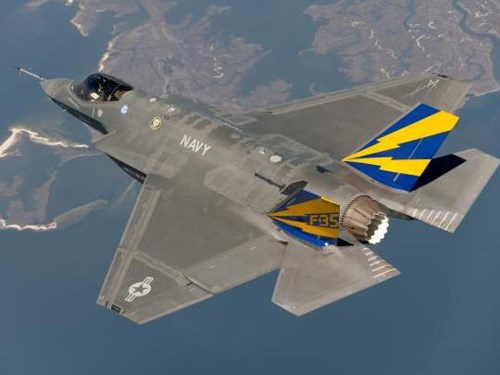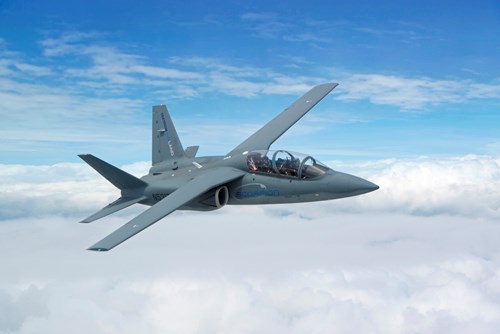Fighter jet development and the "need" for the F-35
The F-35 is expensive, behind schedule and here to stay, but Textron Airland's new Scorpion might better show how a plane should be developed.

Although several years behind schedule and many billions of dollars over budget, the composites-intensive F-35 Lightning II fighter jet is expected to be a core of the U.S. and its allies' fighting arsenal for many years to come.
The Soviet Union tested its first nuclear weapon on Aug. 29, 1949, about five to 10 years before the United States expected it would. The test effectively ended the U.S. monopoly on fission-based nuclear weaponry and launched the decades-long arms race that became the hallmark of the Cold War.
The natural tendency for the Americans was to attempt to regain the upper hand, either by building more fission weapons in effort to stay ahead of the Soviets, or build a bigger weapon. The bigger weapon would be a thermonuclear or fusion-based bomb, which until 1949 existed on the drawing board only as a conceptual weapon. A thermonuclear bomb, fueled by hydrogen, would be orders of magnitude more powerful and destructive than the uranium- and plutonium-based bombs dropped on Japan at the end of World War II, but would require a significant technical effort to develop and test. President Harry Truman faced a simple question: Whether or not to try and make a thermonuclear weapon, or just build more weapons based on the “old” fission technology.
Robert Oppenheimer, physicist and “father” of the atomic bomb developed in the Manhattan Project, actually opposed development of a thermonuclear weapon. It was, he argued, not a battlefield weapon, but a tool used only for destruction of entire cities and regions. It would be, in short, too costly to develop and too destructive to apply. However, faced with the prospect that the Soviets would certainly not show similar restraint, Truman had no choice but to authorize a thermonuclear weapon development program. The U.S. successfully tested its first hydrogen bomb in 1954, followed by the first Soviet hydrogen bomb test in 1955.
There are, today, shades of some of the same “race” logic at work with the F-35 Lightning II Joint Strike Fighter, being built by Lockheed Martin for sale to the U.S. and several partner countries. The composites-intensive F-35, as has been well documented, is about seven years behind schedule and billions of dollars over budget. This has prompted calls for the program’s end, which seems unlikely given that the F-35 and its variants are in testing and early production. The argument has also been made that many of the current jet fighters in the U.S. arsenal can do what the F-35 can do.
Indeed, the U.S. and its allies have relied on fourth-generation fighters like the Boeing F/A-18E/F Super Hornet, the Eurofighter Typhoon, the Dassault Rafale and the Lockheed Martin F-22 Raptor for about 20 years. These planes have served well and continue to perform — and might be adequate for the foreseeable future. The problem is that, like it or not, other countries that may or may not be antagonistic to the U.S. and its allies are developing fifth-generation fighters on par with the F-35. These include the Russian Sukhoi PAK FA and the Chinese Chengdu J-20, so keeping up with the competition seems to demand a fighter like the F-35.
But is fighter jet development done at any cost? Had the U.S. Congress known up front what the true cost of the F-35 would be, it likely would not have authorized it. And it would be nice to think that the U.S. and its allies had gotten so good at airplane development that cost and time overruns were the exception, not the rule. But the F-35 is a complex system, and complex systems invite unpredictability.
There is hope, however, in the fighter jet development world for creativity, speed and efficiency. Witness in particular the recently debuted Scorpion, an all-composite, tandem-seat, twin tail tactical jet fighter, self-funded and developed by Textron Airland LLC (Wichita, Kan.), a joint venture between Textron and Airland Enterprises. The plane went from concept to first flight in just two years, was designed and produced in secret and demonstrates clearly the potential for efficient and on-time fighter development. Scorpion is not an F-35 replacement, but it does prove what’s possible and might be more a harbinger of what’s to come.

The Textron Airland LLC Scorpion fighter, which was introduced in July 2014, was self-funded and evolved from concept to first flight in just two years.
Related Content
Cryo-compressed hydrogen, the best solution for storage and refueling stations?
Cryomotive’s CRYOGAS solution claims the highest storage density, lowest refueling cost and widest operating range without H2 losses while using one-fifth the carbon fiber required in compressed gas tanks.
Read MoreMaterials & Processes: Resin matrices for composites
The matrix binds the fiber reinforcement, gives the composite component its shape and determines its surface quality. A composite matrix may be a polymer, ceramic, metal or carbon. Here’s a guide to selection.
Read MoreThe state of recycled carbon fiber
As the need for carbon fiber rises, can recycling fill the gap?
Read MoreA new era for ceramic matrix composites
CMC is expanding, with new fiber production in Europe, faster processes and higher temperature materials enabling applications for industry, hypersonics and New Space.
Read MoreRead Next
Composites end markets: Energy (2024)
Composites are used widely in oil/gas, wind and other renewable energy applications. Despite market challenges, growth potential and innovation for composites continue.
Read MoreFrom the CW Archives: The tale of the thermoplastic cryotank
In 2006, guest columnist Bob Hartunian related the story of his efforts two decades prior, while at McDonnell Douglas, to develop a thermoplastic composite crytank for hydrogen storage. He learned a lot of lessons.
Read MoreCW’s 2024 Top Shops survey offers new approach to benchmarking
Respondents that complete the survey by April 30, 2024, have the chance to be recognized as an honoree.
Read More


















.jpg;maxWidth=300;quality=90)







